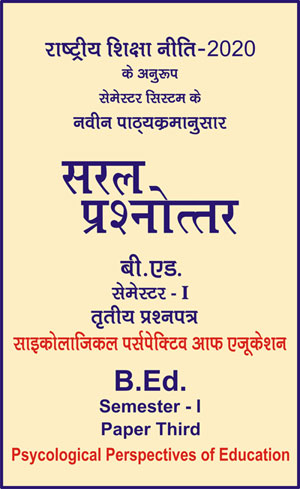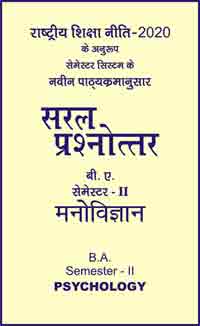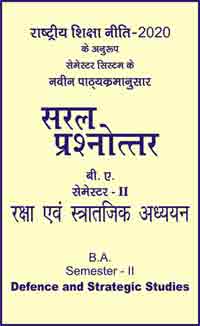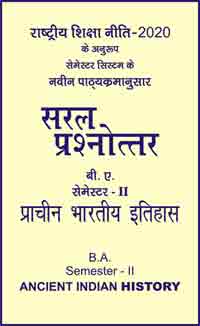|
बी एड - एम एड >> बी.एड. सेमेस्टर-1 प्रश्नपत्र-III - साइकोलाजिकल पर्सपेक्टिव आफ एजूकेशन बी.एड. सेमेस्टर-1 प्रश्नपत्र-III - साइकोलाजिकल पर्सपेक्टिव आफ एजूकेशनसरल प्रश्नोत्तर समूह
|
5 पाठक हैं |
|||||||
बी.एड. सेमेस्टर-1 प्रश्नपत्र-III - साइकोलाजिकल पर्सपेक्टिव आफ एजूकेशन (अंग्रेजी भाषा में)
Question- Describe the Thorndike’s Stimulus Response Bond Theory.
Answer-
Thorndike’s Stimulus Response Bond Theory
Edward L. Thorndike’s propounded this theory in his book ‘Animal Intelligence’. This principle is known as many names :
• Theory of Relation.
• The Principle of Stimulus Response.
• Theory of Learning Relationship.
• Theory of Trial and Error.
Relationalism in the field of learning psychology is a relationship of response to stimulus. The relationship is later established between the stimulus and the response. Hence it is known as stimulus-response theory. In this theory, there is the innate factors of the individual as well as the stimulus response. In this theory, the interaction between the external and internal stimuli of the stimulus response along with the innate factors of the individual remains. Stimulus response theory is a comprehensive theory in the field of learning psychology.
According to psychologists, behind every action there is a stimulus which has an effect on the person and he reacts accordingly. Thus stimuli is related to response. In Thorndike, emphasis has been laid on establishing a link between stimulus and response for learning. Due to the emphasis on this contract, the learning theory is called ‘Stimulus-Response Bond Theory’. This principle belongs to the relational latter and is a part of associative theory. According to Thorndike, a relationship is established between two or more experiences. Every action has a stimulus that causes a response which affects the stimulus. As a result he responds. Thus a specific stimulus becomes related to an response.
The principle of Thorndike is based on the following three elements:
(1) Stimulus or S – Includes environment.
(2) Response or R – displays the action.
(3) Stimulus, Response, the contracting element that establishes the relationship between the stimulus and the response.
According to this principles, cooperation is established between stimulus and response. It is displayed as a sign (S → R). The rules of learning on the basis of convenants have been presented by Thorndike. Thorndike did many experiments on cats, fish, monkeys and humans to establish his theories. The experiments, done on cats are most important. Thorndike’s theory is a type of basic learning known as trial and error based on experiments, done on cats. The learning theory of Thorndike is fundamentally known as the stimulus – response contract theory because contracts are established through trial and error.
Main Features of Stimulus-Response Theory
The main features of stimulus response contract theory are as follows :
(1) Learning is the establishment of a connection between the stimulus and the response.
(2) The process of conditioning in stimulus and response takes place only through trial and error.
(3) Through trial and error, learning becomes efficient in making a definite response to a certain stimulus. For this, he selects the correct response from the other possible responses. Therefore this theory is also, called the theory of selection.
(4) The process of learning is mechanical. Selecting their correct response, it is possible only after slowly removing it.
(5) According to the stimulus, there is response and accordingly the behaviour of a person is determined.
(6) This theory has provided a scientific basis of the learning process, in the field of educational psychology.
(7) This theory is a form of companion theory.
Limitations of Stimulus-Response Theory
Stimulus-response contract theory not with standing many features, there are also many limitations which are as follows :
(1) There is no proper explanation of stimulus and response in this theory.
(2) This theory is called Atomic Theory.
(3) In this theory, the emphasis is on futile, attempts to learn an action.
(4) Behaviouralists criticized the law of effect or result, saying that the process of learning has been unexplained in it.
(5) According to the Gestalt litigants experience itself consists of a relationship. We find it in its totality. So there is no need for any kind of relationship building.
|
|||||














